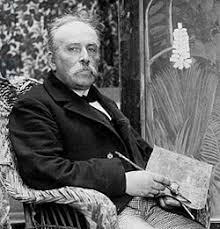Henri Rousseau
Tiger in a Tropical Storm is on display at Roost in West Street
Henri Rousseau was the part-time painter whose jungle fantasies set the art world alight and showed Picasso how to paint. Jonathan Jones on the secret influence of Rousseau.
Henri Rousseau (1844 -1910) was a French post-impressionist painter. His flat and apparently childlike style was ridiculed in his lifetime, but later he was recognised as a self=taught genius. He claimed he had “no teacher other than nature’ . He was admired by Picasso, Leger and the poet Apollinaire, but generally regarded as a complete eccentric. Picasso found a canvas being sold to be repainted, recognised Rousseau’s genius and held a banquet at his studio in Rousseau’s honour, attended by a number of famous artists and writers.
He did not begin painting seriously until his early forties. At 49 he left his job of collecting taxes on goods entering Paris (which earned him the nickname Le Douanier, the customs officer) to concentrate on his art work full time, supplementing his pension with part-time jobs and playing a violin in the streets.

1907, photo: Dornac
See also this excellent article by Jonathan Jones about Henri Rousseau from the Guardian. theguardian.com/artanddesign/2005/oct/29/art
He is best known for his jungle fantasy pictures, but he never left France. He was inspired by illustrations in children’s books, visits to the botanic gardens and taxidermy collections. He said, “When I go into the glass houses and I see the strange plants of exotic lands it seems to me that I enter into a dream.”

Is this tiger cowering from the flash of lightning, or is it stalking prey? Could that prey be explorers?
Tiger in a Tropical Storm, also known as Surprised!, was the first of Henri Rousseau’s iconic jungle paintings. It shows a tiger in the jungle, illuminated by lightning, and either preparing to pounce on its prey, or cowering from the sudden flash.
It was first exhibited at the Salon des Indépendants in 1891 and was mocked by some critics for its “childish” composition and, the flatness of the tiger and surrounding foliage, grass, trees and plants, which showed a lack of academic instruction. However, this flatness is now celebrated as part of Rousseau’s naïve style. The lashing rain was painted using diagonal stripes of translucent silver paint.
Surprised! was the first of around 20 ‘jungle’ paintings that Rousseau produced, which are among his most popular works. These jungles are entirely imaginary: Rousseau never left France. The plants depicted were inspired chiefly by his frequent visits to the Botanical Gardens in Paris and domestic house plants, and his tiger may have been inspired by the zoo in the Gardens, as well as its Zoology Galleries, which exhibited stuffed animals. Tigers had also been depicted by Eugène Delacroix and were shown in non-fiction books, which were both other possible sources of inspiration.
Rousseau was a self-taught amateur artist who took up painting as a hobby. He viewed his painting very seriously, despite facing ridicule from some quarters. But a number of artist and writers, particularly from the avant-garde, hailed him as an important figure. He is now seen as a pioneer of ‘naïve art’.
